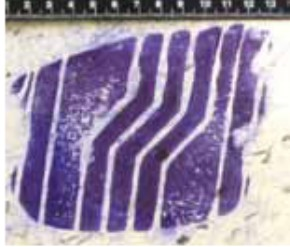Latent Blood Prints — Methods For Chemical Enhancement
Don Penven
Blood is often found on various surfaces at crime scenes where physical violence occurred. Therefore, blood acts as a transfer medium for latent fingerprints and shoeprints. On some occasions the blood residue retains enough color and detail to permit direct photographic recovery, but generally the blood marks are too faint to permit photography using conventional light sources.
In a report published by the California Department of Justice, Bureau of Forensic Services. scientists conducted significant research indicating that certain reagents may be introduced to the visible stains or areas suspected of containing latent blood impressions.
For many years, forensic scientists have used reagents such as Leucomalachite or Ninhydrin to develop blood stains, but both of these substances have a tendency to run off or distort the prints on non-porous surfaces. On the other hand, Amido Black has proven to be quite useful.
This article reviews three popular methods for blood print enhancement: Amido Black, Leuco Crystal Violet (LCV) and Hungarian Red
Amido Black
Amido black is very sensitive and works well on non-porous surfaces but its high background color (light to medium blue) compromises contrast on multi-colored porous surfaces.
Amido Black is a protein stain, and as such should not be considered as even a presumptive test for blood, let alone a confirmatory test. The protein may be present in other body fluids, in addition to blood. However, other actual presumptive tests may be successful after the application of amido black.
The Amido Black staining solution can be methanol—or water-based. Amido Black in methanol has a greater staining power, but due to the toxicity of the methanol, it is also more dangerous. For use on a crime scene (for example, shoeprints in blood) the water-based staining solution is advised.
Amido Black Aqueous Solutions—Field or Lab Use
To Create an Aqueous Fixing Solution—Solution No. 1 (makes 1000ml):
- Weigh out 20g of 5-Sulphosalicylic Acid. Place in a clean, dry, 2 liter glass beaker.
- Measure out 1-liter of Distilled Water. Add to the 5-Sulphosalicylic Acid while stirring with a magnetic stirrer. A clear water-based Fixing Solution will be produced
- Transfer the water-based Fixing Solution to a clean, dry, labeled, 1 liter plastic coated glass bottle equipped with a tightly fitting screw cap. (Unused water-based Fixing Solution will keep indefinitely.)
To Create An Aqueous Working Solution—Solution No. 2 (makes 1000ml):
- Weigh out 2g of Amido Black. Place in a clean, dry, 2 liter glass beaker.
- Weigh out 20g of citric acid. Add to the Amido Black.
- Measure out 1 liter of distilled water. Add to the beaker. Stir with a magnetic stirrer for at least 30 minutes. A blue-black working solution will be produced.
- Transfer the water-based Working Solution to a clean, dry, labeled 1 liter plastic coated, glass bottle with a tightly fitting screw cap. (Unused water-based Working Solution will keep indefinitely.)
Amido Black Application Procedure:
Aqueous Solutions
Note: The fixing and working solutions may be applied using a spray application. For tray development follow the procedure below:
Photographs of any visible prints must be taken before proceeding. Important Note: Before using this technique on a corpse, clear the procedure with the Coroner’s or Medical Examiner’s Office.
- Pour sufficient water-based fixing solution to treat the article into a clean, dry, metal dish or pan.
- Immerse the article in the fixing solution for five to six minutes. Longer times may be needed to fix heavy blood deposits. Beware of cross-contamination of DNA evidence if more than one article is processed. Discard the water-based fixing solution.
- Pour sufficient water-based working solution into a clean, dry, metal dish or pan to treat the article. Pour a similar volume of distilled water into two other containers. If the article cannot be fully immersed, apply the working solution and distilled water using a wash bottle above the prints, and allow the solutions to run down over the prints.
- Immerse the article in the working solution for three to four minutes. Working solution may be replenished as needed. Discard used working solution when complete.
- Immerse the article in distilled water. Rock the dish gently until excess dye has been removed from the background and greatest contrast is achieved between the prints and the background.
- Allow the article to dry at room temperature.
- Photograph useful prints.

Amido Black Latent Print
Staining can be cleaned using a solution of 10% bleach.
Leuco Crystal Violet
This reagent does not react to the normal finger constituents found in latent fingerprints like eccrine or sebaceous deposits. Rather, this reagent has an affinity for heme-based materials. When LCV and hydrogen peroxide come into contact with the hemoglobin in blood, a catalytic reaction occurs and a blue to purple/violet reaction product occurs. Leuco Crystal Violet may be used on both porous and non-porous surfaces, and may be applied with a fine mist spray or by immersing an object in the solution.
A number of sources offer LCV in kit-form, with pre-packaged and pre-measured reagents.

LCV Shoeprint on tile floor
Hungarian Red
Hungarian Red was developed through a cooperative effort of the police forces in Hungary and Holland. The intent was to create a formula that would be highly sensitive to blood residue, and subsequent testing has indicated that Hungarian Red may be more sensitive than other processes such as Amido Black.
Hungarian Red is an aqueous solution for staining impressions found in blood. It is much safer than other staining compounds due to its water-based formula. It has been used in actual crime scenes to recover nearly invisible latent fingerprints and footprints in blood. NOTE: As with similar chemicals, collect all DNA evidence from the crime scene before using Hungarian Red because this process will interfere with subsequent blood analysis. Do not use Hungarian Red on handwriting samples, inks, hairs, fibers, and other physiological fluids that will be subsequently subjected to other forms of forensic examination.
Hungarian Red may be used on most porous and non-porous surfaces.
Lifted traces and weak traces on dark or confusing backgrounds fluoresce under a green alternate light source (520nm-560nm) such as the, MMX100 megaMAXX™ and MMX300 megaMAXX™ III. Once fluoresced, view and photograph the evidence with orange or red barrier filters.
PROCEDURE
Hungarian Red is supplied in sprayer containers. Place small objects in a suitable tray and spray the reagent onto the object from a distance of 6"-9" (15.2cm-22.9cm). Allow about one minute for the dye to set. Then, wash lightly with water or a water/acetic acid mixture. Remove any remaining water droplets with compressed air or a hair dryer set on low heat. The surface must be completely dry before attempting to lift the developed prints using gelatin-type lifters. When examining larger objects, apply the reagent directly to the surface.

The left side of this image shows
visible red staining from Hungarian Red. It
fluoresces when excited with 520-560nm (right).

About the Author
Don Penven has more than 35 years direct and indirect experience in law enforcement. He currently serves as a technical support representative and technical writer for Sirchie Finger Print Labs.
Article submitted by the Author
Article posted: January 22, 2013

